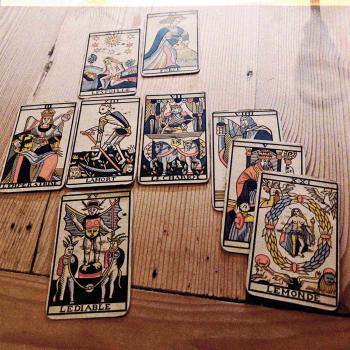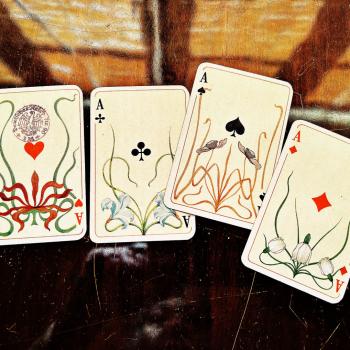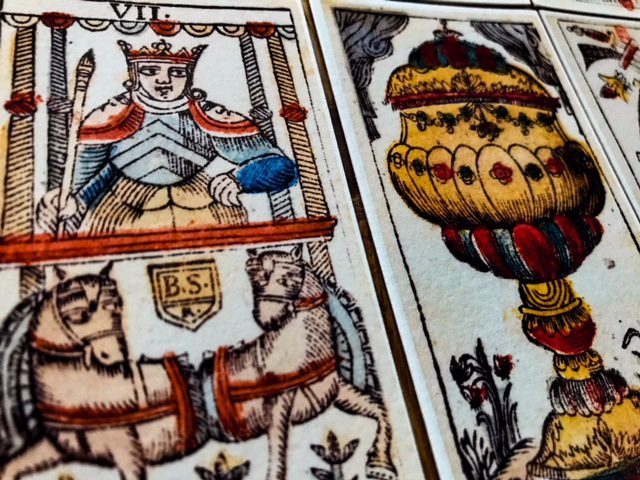
This theory applies to the Marseille type of cards, or any other historical deck that has no figurative illustrations on the cards à la the popular Waite-Smith Tarot that features cartoon-like vignettes on every card.
You look at the geometrical arrangement on the cards, and go:
‘Oy. Not only am I unable to distinguish between the goddamn swords and batons, but I simply also don’t see how I can read these cards without a solid book of meanings.’
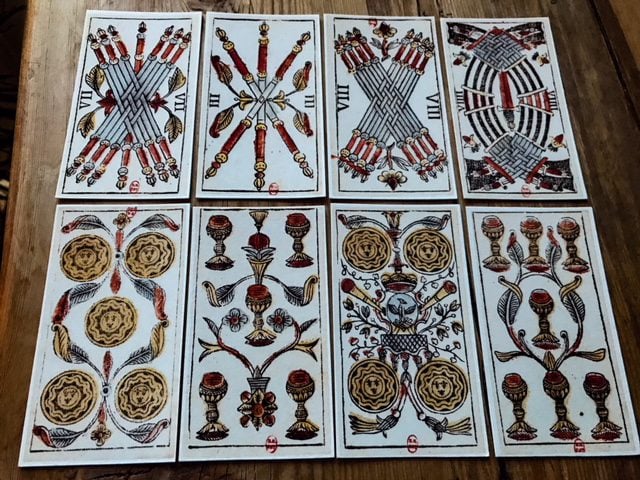
Well, yes. There is such a thing as confusion. There is also such a thing as a book of meanings.
But here’s a thought: In the face of the actually very, very simple, how useful is confusion and how useful is a book of meanings?
Paradoxically, symbolic meanings, random associations, and systems of correspondences are there to create more confusion, not cut through it.

Just think: You look at the card of 4 Cups in the Waite-Smith Tarot, and you experience relief: ‘yay, the meaning of this is boredom.’
Maybe.
Try putting this card next to the Ace of Swords. What would you say now? Does boredom still apply? And if it doesn’t, what do you do? Force it down the sharp road? Or dismiss it quickly, as you’d rather not admit that you actually have no idea.
Connection and metaphor
Here’s what I say in concise form – nothing new though, if you’ve taken my cartomancy courses or payed attention to the hundreds of essays I’ve written here and on Taroflexions.
In our work with the cards, we talk about nothing other than connection and path-work, ways to connect, ways to reconnect if disconnection happens, and so on.
Especially the pip cards emphasize connection. In contrast, the trumps have a stronger individual force, where we actually see that the reason why the trumps are strong and appear individual is because ‘connection’ is already part of the program. Connection is not raised to higher status, when it already has high status.
Think about that. Think about the Emperor and how he relates to connecting and networking. Do you think that the Emperor needs liking?
Historically, there have been Emperors obsessed with having people like them – think of Nero – but that has always proved to be the wrong approach.
All narcissists and others who merely claim super connecting powers, yet demonstrate the opposite, end up beheaded or in the ditch. Why? Because they don’t get ‘connection;’ because they completely misunderstand what connection is essentially, namely, that it is all pervasive and encompassing.
You can never NOT connect.
This is the subtle message of the pips. I’ve already written about the subtle power of the trumps, but where the pips are concerned, what I find utterly fascinating is the fact that when the suits connect to the function of the trumps, or simply interconnect when no trumps are in the picture, what they do is teach a lesson in temporal and spatial awareness.
What I’m saying is this: All pip cards can be understood in terms of how we also understand temporal and spatial metaphors in a structural, binary, and numerical order: inside/outside, up/down, far/near, strong/soft, fast/slow, here/there, a little/a lot, sharp/dull, moveable/immovable, and so on – and yes, the latter, ‘and so on’ is also very much a representative of what pip cards can also act as: as conjunctions, appositions, pauses, ellipsis, and adjectival and adverbial modifiers, including objections of this type: ‘yes, but’, and so on. You get the picture.
As I’ve already written a ton about this, and I don’t want to merely repeat myself, I want to make this explicit point:
When you read cards in line, something a lot of people find strenuous, what you do is actually activate this type of vocabulary, rather than the one that prioritizes lists of meanings devoid of the dynamic power of connecting.
Connecting 13 cards in 1o seconds
Let me give a concrete example.
I’ll read below a classical square of 13 cards from the French tradition, where the first card either emphasizes the significator, or is about the theme of the reading when no question is asked.
In my case here, and unlike my regular practice, I let the first card determine the theme. The card at the bottom is the surprise. I always read this as a full stop or as a punchline to the narrative that I come up with.
I won’t unpack the reading, as I normally do in the context of a class, but rather just go for it, with complete disregard for standard symbolic meanings (obviously I’m well-aware of the fact that metaphors are also ‘meanings’ since they are part of linguistic conventions, but what I’m interested in here is more what we do with words rather than what words with do us).
Therefore, the only thing that interests me is sticking to the commonsensical knowledge of what I can logically infer is the function of each suit:
To drink with the cups, to transact with money, to build with batons, and to stab with the swords.
This the only principle of the strategy of reading the cards, as it relates to the idea of either scarcity (1) or multitude (10).
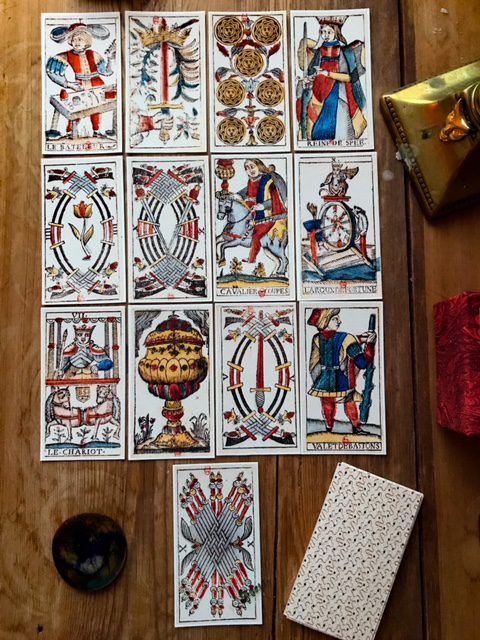
Let’s see what the Magician, the first card down here, has to say. The premise for my reading takes point of departure in what I can presume a Magician does: Show his skill at entertaining with the purpose of earning some money. This is the theme of my reading.
Had the Ace of Swords been my first card, I would have said that the theme would be to be utterly sharp and cut through whatever the other cards would show is the case.
Let’s look how we can proceed with having nothing in the head other than a sense of how we can manipulate with the temporal and spatial metaphors, as they lend themselves to the idea of connection (pips) in relation to function (trumps and court cards).
I will also read this in one single line that often takes me no more than 10 seconds to produce.
You can be the judge of the extent to which this method of reading the pip cards makes sense, or is useful. I myself like it a lot, simply because it never wastes my time.
The magical one-liner
The Magician would rather not play with any sharp object (AS) in order to gain money (7D) but he can’t run from the Queen of Swords who makes sure to remind him of how his painful indifference towards lovely offerings (4S, 10S, KC) leaves everything to Fortune who favours even the bold ones (Charioteer) who can never get enough of big cakes (AC), in spite of the pain thereafter (5S) induced by having to dismount and exercise with a stick in order to make the indigestion go away.
Ah, work! So much work for so little money. 13 cards and only one related to money…
Why so much pressure? Who likes to work so much?
Not the Magician. It’s clear that this one here is not very efficient, dodging what needs to be addressed ever so sharply, and only pursuing soft and fluffy things that you can put in your mouth.
Enjoy your connections and your metaphors.
♠
The essay here is loosely based on a chapter in my forthcoming book, The Power of the Pips (ca. February), as well as my teaching of the Marseille foundation course (starting again in early February).
Stay tuned for the calls, if you’re interested in following.







